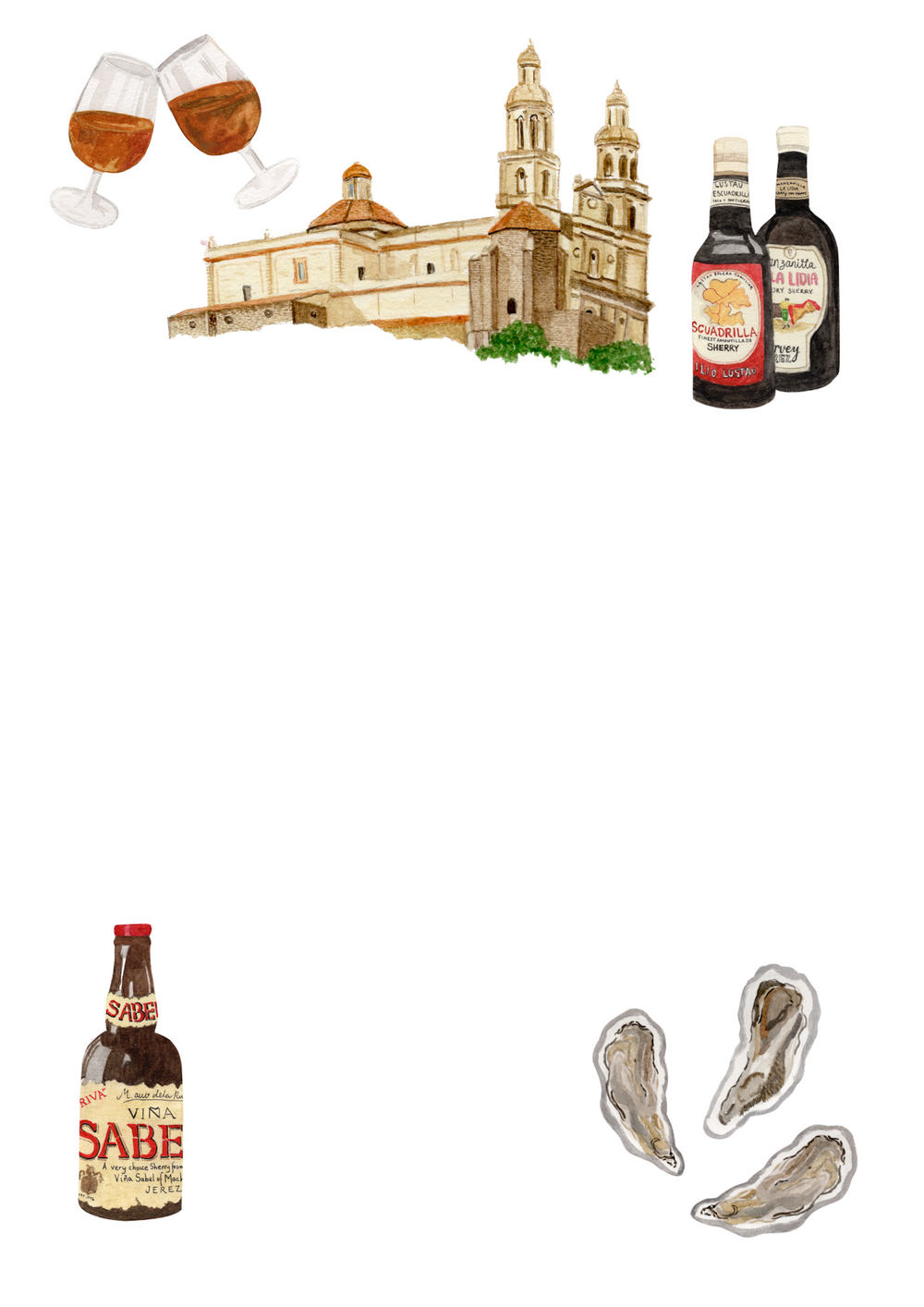CommunityCultureFood & DrinkLifestyleWine
Noah May on Wine: Jerez in the Afternoon
By Noah May
Oct 28, 2022

Illustration by Mimi Dickson
The only time I visited Jerez, it was by mistake. On this occasion, my wife and I had booked a hotel in Jerez de la Frontera, instead of booking one in Vejer de la Frontera, where our friends had rented a house for the summer. We were only joining for two days, so decided to stay in Jerez for one night and explore.
This was around 2010, and a little Googling en route from the airport informed me that the post credit-crisis years hadn’t been too kind on Jerez. The town was on the verge of going bust. The parks couldn’t pay their staff, and the zoo was alleged to be selling off its animals, so dire were these straits. I suddenly felt rather concerned. Thankfully, I need not have worried: Jerez was wild, but as charming and unique as any city I’ve visited. There were few signs of discord around town, but many indications of people finding joy in the simplest of things.
August in Andalucía is quietly brutal. The ever-present sun bakes cobbled streets, where wild dogs lie splayed out, anxious to cool themselves from the midday heat. After checking in to the guest house, we amble through the town looking for sustenance and refreshment.
The first bar we find is straight out of Hemingway, if Hemingway had been edited by Charles Bukowski. The small, smoke and oil-stained room is full of characters who look like they’ve escaped from something ominous, and are celebrating their new-found freedoms. Flamenco music plays fervently; there is a feral beauty to the cadence of the room.
I buy a half bottle of Fino sherry for three euros and we stand outside in the street, drinking with the other patrons. They welcome us into the midst of the action. There is dancing and mildly unhinged conversation. There are false teeth and a missing eye. We share our wine, buy more, are given more, share more, and this pleasant rhythm continues until dusk, when we are dragged off to a church for an impromptu flamenco performance. It’s one of the great days of my life — it feels like the quintessence of conviviality.
Sherry is perhaps the most exquisite and under-appreciated wine on the planet. There are the obvious, hackneyed jokes of creaky great aunts sipping Harvey’s Bristol Cream at Christmas, but the true picture is more multifarious than most could imagine. There is perhaps no other wine that is as versatile and profound as sherry.
Sherry has to be produced in the triangle of Andalusian towns of Jerez de la Frontera, Sanlucar de Barrameda and El Puerto di Santa Maria. Wines made from grapes grown in vineyards around these towns are then fortified after fermentation with neutral grape spirit to increase the alcohol level. Most wines are made from white palomino grapes, but some sweet wines also come from Pedro Ximenez and Moscatel.
After the spirit is added, sherry is generally split off into two groups. The lighter, more delicate wines are left to evolve into Fino and Manzanilla — wines that are aged biologically under a layer of yeast or flor as it is known in the region. The heavier, mas gordo, robust sherries are selected to undergo a period of oxidative ageing, where more alcohol is added to kill off the flor, resulting in an exposure to air that allows the wines to grow into an altogether different beast and take on a kaleidoscopic range of flavour characteristics depending on how long the wine ages and under what conditions.
The greatest bottles of Fino are typically golden-green flecked masterclasses in poise and subtlety with notes of freshly baked bread, green apples and Marcona almonds. They are generally designed to be drunk in youth, but have the ability to age beautifully too.
When time, more spirit and air get involved, they lead the wines on toward its final destiny as an Amontillado, Palo Cortado or Oloroso. These wines can take on flavours ranging from saffron and caramel to smoked meats, furniture polish and roasted walnuts. The sweeter styles of Pedro Ximenez and Moscatel are versatile too, enormously multi-faceted and age-worthy – these wines can live for centuries.
Sherry is also one of the great wines for matching with food and make a merry dance with the most challenging of partners. Fino is great with oysters; Palo Cortado with pheasant biryani — try it! Finally sticky, sweet Pedro Ximenez is one of the few wines that stands up to both dark chocolate and blue cheese!
Returning to that long night in Jerez, we are walking home, heads ringing from the insistent beat of the flamenco performance we’ve just witnessed. We amble through those cobbled streets with a great sense of calm. These alleys take us through the centre of Jerez toward the hotel. We look up at the ancient sherry bodegas – Gonzalez Byass, Valdespino, Lustau, Hidalgo – all evocative testaments to centuries of tradition.
The streets are all-but-empty now and there is a welcome breeze off the Strait of Gibraltar; the air is faintly redolent of smoke, fruit, old barrels and the warm, musty corners of these cellars that give life to this town and its wines. Here in this hinterland between Europe and the African continent, there’s magic hiding away in these cathedrals of wood and booze.
My only advice to you all is drink more sherry.


